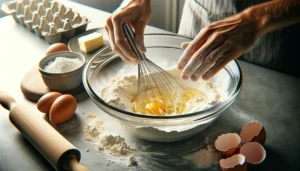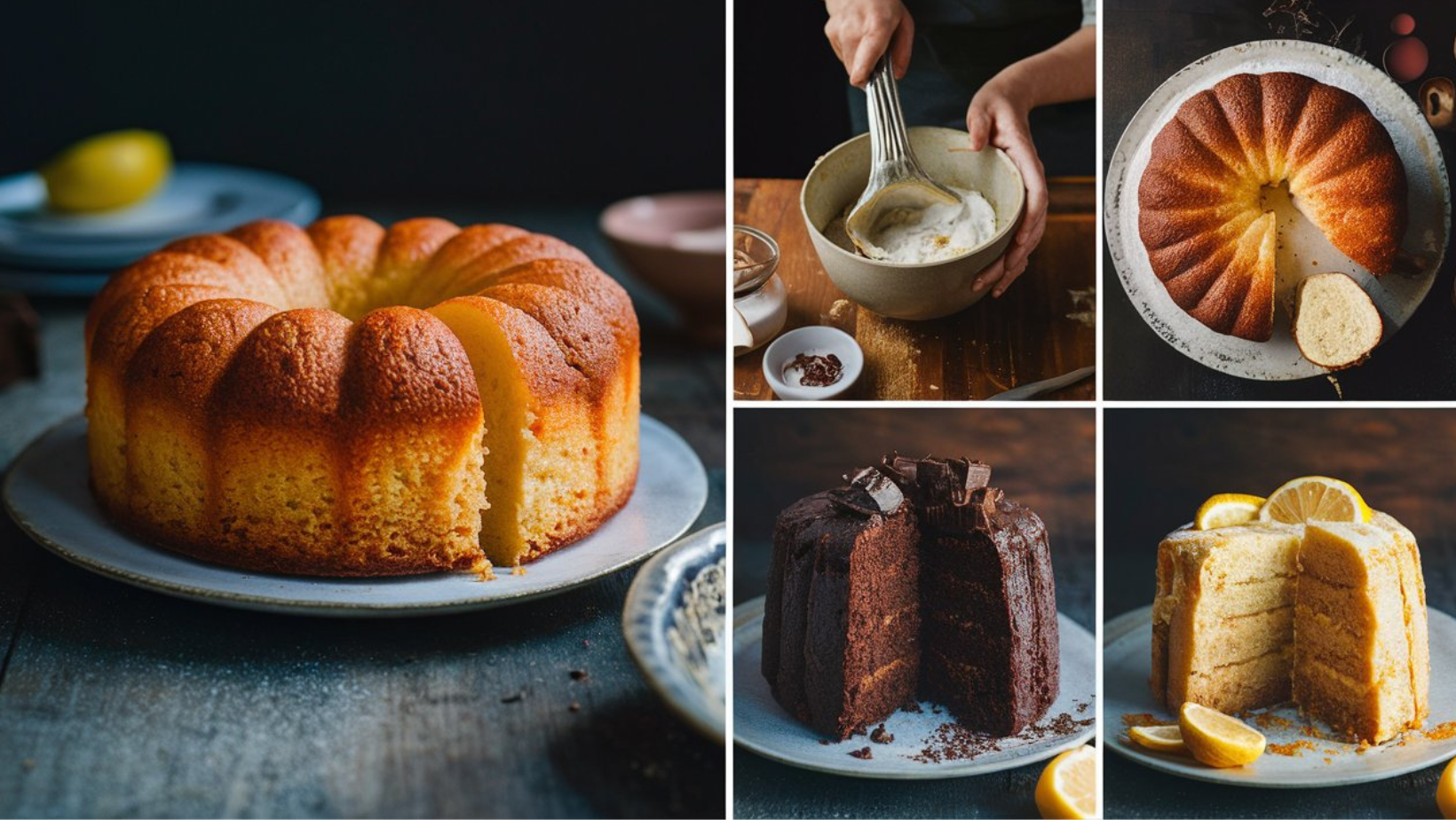Classic Butter Cake Recipe
Preparing Your Ingredients
Before you begin, ensure all your ingredients are at room temperature — this is a game changer. Ingredients like butter and eggs blend more smoothly when they aren’t cold, which can help prevent issues like curdling. Start by prepping your station: measure out each ingredient, and have your pans greased and lined. This upfront organization, often referred to as ‘mise en place,’ ensures the baking process goes smoothly without any forgotten elements.
Mixing Methods for Optimal Texture
The creaming method is paramount for a fluffy butter cake. Begin by beating the butter and sugar together until they are pale and fluffy. This process incorporates air into the batter, which helps to give the cake its light texture. Next, add the eggs one at a time, beating well after each addition. This gradual mixing ensures that each egg is fully incorporated into the batter before the next is added, maintaining the structure. understanding of how various factors like ingredient selection, mixing technique, and baking conditions contribute to the texture of a cake.
Baking Tips for Perfect Consistency
Baking your cake at the right temperature is crucial. A moderate oven, around 350 degrees Fahrenheit, is ideal. It’s important to avoid opening the oven door frequently, as the rush of cold air can cause the cake to fall. Bake until the cake is golden brown and a skewer inserted into the center comes out clean, typically about 30-40 minutes, depending on your oven.
Cooling and Serving Suggestions
Once your cake is done, let it cool in the pan for about 10 minutes before transferring it to a wire rack. This allows the cake to firm up and makes it less likely to break when removing it from the pan. After it has completely cooled, you can dust it with powdered sugar or spread your favorite frosting on top. For a truly delectable experience, serve your butter cake slightly warm with a dollop of whipped cream or a scoop of vanilla ice cream.
The steps involved in making a butter cake are not just about following a recipe—they’re about understanding how each component works together to create a symphony of flavors and textures. So, take your time and enjoy the process of creating something delicious from scratch!
Small-Batch Butter Cake Recipe
| Ingredient | Quantity | Relevant Details | Benefits |
|---|
| Butter | 1/4 cup | Softened, unsalted preferred | Provides richness, moisture, and flavor; foundation for texture |
| Sugar | 1/3 cup | Granulated | Sweetens the cake; helps with browning and texture when creamed with butter |
| Eggs | 1 large | Room temperature | Adds structure and stability; emulsifies the batter |
| Vanilla Extract | 1/2 tsp | Pure extract for better flavor | Enhances flavor complexity |
| Flour | 2/3 cup | All-purpose | Builds structure; soft flour like cake flour can be used for a lighter texture |
| Baking Powder | 1/2 tsp | Ensure it’s fresh for best results | Acts as a leavening agent, helping the cake rise |
| Milk | 1/4 cup | Any type (whole preferred for richness) | Moistens the batter, activates gluten slightly for structure |

Instructions
- Preheat Oven and Prepare Pan:
- Preheat your oven to 350°F (175°C).
- Grease and flour a small 6-inch cake pan or line it with parchment paper.
- Cream Butter and Sugar:
- In a mixing bowl, cream together the softened butter and sugar until pale and fluffy. This introduces air into the mixture, helping the cake rise.
- Add Egg and Vanilla:
- Beat in the egg and vanilla extract until well combined. Ensure the egg is fully incorporated to prevent the batter from separating.
- Combine Dry Ingredients:
- In a separate bowl, sift together the all-purpose flour and baking powder.
- Mix Dry and Wet Ingredients:
- Alternately add the dry ingredients and milk to the butter mixture, starting and ending with the flour. Mix until just combined after each addition to keep the batter light and airy.
- Bake:
- Pour the batter into the prepared pan and smooth the top with a spatula.
- Bake in the preheated oven for about 25-30 minutes, or until a toothpick inserted into the center comes out clean.
- Cool and Serve:
- Allow the cake to cool in the pan for 10 minutes, then turn out onto a wire rack to cool completely.
- Once cool, you can dust it with powdered sugar or top it with a simple glaze if desired.
This recipe is perfect for a small gathering or when you want a delightful treat without leftovers. Enjoy your homemade butter cake with a cup of tea or a scoop of ice cream for added indulgence!
Creative Variations of Butter Cake Recipe
Adding Flavors and Toppings
Butter cake is wonderfully versatile. To personalize your cake, consider adding citrus zest, such as lemon, lime, or orange, to the batter for a bright, fresh flavor. Alternatively, spices like cinnamon or nutmeg can add a warm, comforting note. For those who love a bit of texture, sprinkling the top with slivered almonds or crushed pecans before baking adds a delightful crunch.
Gluten-Free and Vegan Options
Adapting butter cake recipes for dietary restrictions doesn’t mean compromising on taste or texture. For a gluten-free version, substitute the wheat flour with a gluten-free flour blend designed for baking. Be sure to include xanthan gum if it’s not already in the mix, as it helps mimic the binding properties of gluten. For vegan options, plant-based butters and egg substitutes like applesauce or mashed banana work wonderfully.
Small Changes for Different Occasions
A simple butter cake can be transformed into an elegant dessert with just a few tweaks. For a festive touch, mix crushed candy canes into the batter during the holiday season. If you’re preparing a cake for a birthday party, adding rainbow sprinkles to the batter creates a fun, colorful effect. These small changes not only customize the flavor and appearance but also tailor the cake to suit any event or celebration.
This part of the article aims to inspire you to experiment with your baking, encouraging a playful approach to traditional recipes. With each variation, you not only adjust the taste but also the joy and memories that baking can bring. Whether adapting the cake for dietary needs or a special occasion, these tips ensure that everyone can enjoy a slice of this delightful treat.
Troubleshooting Your Butter Cake
Avoiding Common Baking Errors
A common issue many bakers face is a cake that either rises too much or not enough. This often boils down to the leavening agents. Ensure that your baking powder or soda is not expired, as they lose effectiveness over time. Overmixing the batter can also lead to tough cakes, so mix just until the ingredients are combined. Remember, a few lumps are perfectly fine and preferable for a tender crumb.
Adjustments for Altitude and Humidity
Baking at high altitudes requires specific adjustments since the lower air pressure can affect the rise and baking times. Increase the oven temperature slightly and reduce the baking time. You might also need to increase the flour slightly and decrease the sugar and leavening agent to prevent the cake from rising too quickly and then collapsing. In humid climates, extra moisture in the air can make your ingredients stickier and denser. Combat this by slightly increasing the amount of flour and reducing liquids in the recipe to achieve the right batter consistency.
These tips aim to help you understand and navigate the various challenges that can arise during the baking process. By learning to troubleshoot these common issues, you’ll be able to consistently bake perfect butter cakes that are as delicious as they are beautiful, no matter the external conditions. This knowledge not only makes baking more enjoyable but also empowers you to adapt recipes creatively to suit any environment.
Frequently Asked Questions About Butter Cake
Can I substitute margarine for butter?
While you can substitute margarine for butter, it’s important to note that it will affect both the flavor and texture of your cake. Butter provides a richness and depth of flavor that margarine simply can’t match. If you do need to use margarine, choose a high-quality brand with a high-fat content to get closer to the texture and flavor butter would offer.
How to ensure the cake rises properly?
Ensuring your cake rises properly involves several key factors: using fresh leavening agents, making sure your ingredients are at room temperature, and not overmixing your batter. Also, be careful not to open the oven door too frequently while baking, as the rush of cold air can cause the cake to collapse.
Best frosting and decoration tips?
For a classic butter cake, a simple dusting of powdered sugar might be enough, but if you’re looking to impress, a buttercream frosting works beautifully. You can flavor this with extracts, zests, or spices to complement the cake. As for decorations, edible flowers, fruit slices, and custom sugar art can add elegance and personal touches that make the cake as visually appealing as it is delicious.
With these FAQs, our goal is to address the common curiosities and concerns that might arise as you embark on baking a butter cake. By providing these insights, we hope to enhance your confidence and competence in the kitchen, ensuring that each baking experience is as rewarding as it is enjoyable. Whether you’re a first-timer or a seasoned baker, understanding these elements will help you create perfect butter cakes Recipe every time.
Can I make this cake with whole wheat flour?
Yes, you can use whole wheat flour to make a butter cake, but it will affect the texture and flavor. Whole wheat flour is denser and has a stronger taste than all-purpose flour. To lighten the texture, you might want to use a mix of half whole wheat and half all-purpose flour. Additionally, increasing the leavening slightly can help achieve a fluffier result.
Is there a dairy-free version of butter cake?
Absolutely! For a dairy-free butter cake Recipe, you can substitute the butter with a plant-based butter alternative. Make sure it’s suitable for baking to get the best results. For the milk, any plant-based milk (like almond milk, soy milk, or oat milk) will work. These substitutes should yield a cake that is just as delicious as the traditional recipe.
What’s the best way to store butter cake to keep it fresh?
Butter cake can be stored at room temperature for several days. Just make sure it’s covered in an airtight container or wrapped well in plastic wrap to prevent it from drying out. If you’ve frosted the cake, depending on the type of frosting, you might need to refrigerate it to keep the frosting from spoiling.
By answering these questions, the article aims to assist readers in navigating common concerns and curiosities they might have while baking their butter cakes, ensuring they feel more confident and prepared in the kitchen.


